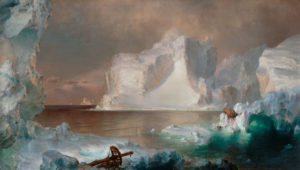Celebrating Aesthetic Innovation in Contact with the Natural World
Sean E. Sawyer, Washburn & Susan Oberwager President
I want to thank the over 300 guests at Olana’s Summer Party: “Icebergs in August” this past Saturday, who joined us for a mid-summer’s evening of sociability in the Hudson Valley focused on celebrating Frederic Church’s quest for aesthetic innovation in contact with the natural world. This year we reveled in his 1861 masterwork “The Icebergs,” and in my remarks I shared its remarkable story.

Landscapes by David Huntington, 1966
In June of 1859, Frederic Church, America’s most celebrated artist, and his good friend Louis Legrand Noble set off for Newfoundland and Labrador in search of icebergs. Church was seeking to capture the sublime, terrible beauty of these natural wonders, particularly their endlessly varied, sculptural forms, and the changing effects of light and weather on their enormous icy masses. As this passage from Noble’s published journal of their trip so vividly describes, these aesthetic adventurers discovered allegorical power in the observation of color most especially:
“Church finds great difficulty in painting, from the motion of the boat; … The moments for which we have been waiting are now passing, and the berg is immersed in almost supernatural splendors. The white alpine peak rises out of a field of delicate purple, fading out on one edge into pale sky-blue. Every instant changes the qualities of the colors. They flit from tint to tint, and dissolve into other hues perpetually, and with a rapidity impossible to describe or paint. … The blue and the purple pass up into peach and pink. Now it blushes in the last look of the sun .. tints of the roseate birds of the south – the complexion of the roses of Damascus. In this delicious dye it stands embalmed – only for a minute, though; for not the softest dove-colors steal into the changing glory, and turn it all into light and shade of the whitest satin. The bright green waves are toiling to wash it whiter, as they roll up from the violet sea, and explode in foam along the broad alabaster. Power and Beauty, hand in hand, bathing the bosom of Purity.”
Louis Legrand Noble, After Icebergs with a Painter, (1861), pp. 176-177.
Following this frigid pilgrimage, Church returned to his studio in Manhattan – Olana was still a dream at this time – and painted the “The Icebergs” over the next 18 months. On April 12, 1861, two weeks before he was to exhibit it publicly, Confederate forces attacked Fort Sumter; Church retitled the painting “The North” and dedicated the exhibition proceeds to the Patriotic Fund. However, he displayed it with his characteristic showmanship, in a room fitted with an emerald green carpet, purple maroon walls and sofas, and with the painting at far end of room in rich, dark frame – creating the effect, as commented on by reviewers, of looking out a window onto the North Atlantic.
Church subsequently exhibited the painting in Boston and London, where it was purchased by Sir Edward Watkin, a railway magnate with interests in Canada, and faded from public view. Indeed, “The Icebergs”—a massive 6’ by 9’ canvas — disappeared for 116 years. When Church’s reputation revived in the 1960s, the hunt for the painting picked up. In fact, it had been hiding in plain sight, in the upper stair hall of Watkin’s former country house, now a boys’ reform school on the outskirts of Manchester.
The painting’s re-discovery in 1979, followed by its sale at Sotheby’s for $2.5million, stunned the art world. It not only smashed the record for an American painting ($980,000 for Caleb Bingham’s “The Jolly Flatboatman”) but also surpassed the record for the highest price paid at an American auction for any work of art ($2.3 million for Rembrandt’s “Aristotle Contemplating the Bust of Homer”). The buyers were Lamar and Norma Hunt, who donated the painting to the Dallas Museum of Art, where it has occupied pride of place for the past three decades. The great success of “The Icebergs” revived international attention for the Hudson River School and Frederic Church
The essence of “Icebergs in August” was the celebration of the artist’s vision in contact with the splendors of nature, to my mind this is the fundamental essence of the Hudson Valley, the birthplace of American art – of art centered on the American condition from wilderness to industrial decline and renaissance through aesthetic and entrepreneurial endeavor. I am new to this spectacular environment and feel privileged to be living and working here. I look forward to getting to know you all in the coming months and years. 2016 will mark 50 years of public ownership of Olana, and The Olana Partnership and New York State Parks will have very exciting news to share about the future of the property and its engagement with our communities’ social, economic, and cultural needs.
I thank all our individual and business supporters, with special thanks to our Presenting Sponsor, Stair Auctioneers & Appraisers, for making “Icebergs in August” possible. I greatly appreciate our dedicated staff at the Partnership and New York State Parks for their tireless work and endless creativity. Last but far from least, I want to express our immense gratitude to our Event Co-Chairs Christine Jones and Bobby Beard; our Auction Co-Chairs Erika Clark and Michael Bennett Levinson; Event Designer Beau Simons; Event Lighting Designer Nick Haddad; and Ice Artist Sean Taylor of Capital City Carvers.
If you were unable to join us this year, please look for The 50th Anniversary Olana Summer Party next year.

